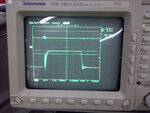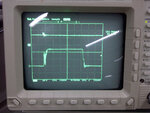gdylp2004
Member level 5
Hi guys,
As seen in the attached schematic, the PWM controls the nMOS by charging and discharging the gate accordingly. While running the buck for a min or two, the MOSFET's TO-220 package temperature rised to about >160 °C and I've burnt 2 nMOS before (note that the max. absolute temperature rating for the IRF640N is 150 °C).
To tackle the prob, I've added a diode anti-parallel with Rgate to provide an alternate path for the gate to discharge upon turning off. However, when I observed my o-scope under the 2 conditions (with and w/o diode), there seems no significant change is the dv/dt of the gate-source voltage. It remains at about 350ns.
Do anyone know why? Could it be the diode's intrisic resistance is also close to 5.6Ω as well?
The diode I used is MUR120 Ultra-fast recovery diode.
As seen in the attached schematic, the PWM controls the nMOS by charging and discharging the gate accordingly. While running the buck for a min or two, the MOSFET's TO-220 package temperature rised to about >160 °C and I've burnt 2 nMOS before (note that the max. absolute temperature rating for the IRF640N is 150 °C).
To tackle the prob, I've added a diode anti-parallel with Rgate to provide an alternate path for the gate to discharge upon turning off. However, when I observed my o-scope under the 2 conditions (with and w/o diode), there seems no significant change is the dv/dt of the gate-source voltage. It remains at about 350ns.
Do anyone know why? Could it be the diode's intrisic resistance is also close to 5.6Ω as well?
The diode I used is MUR120 Ultra-fast recovery diode.


